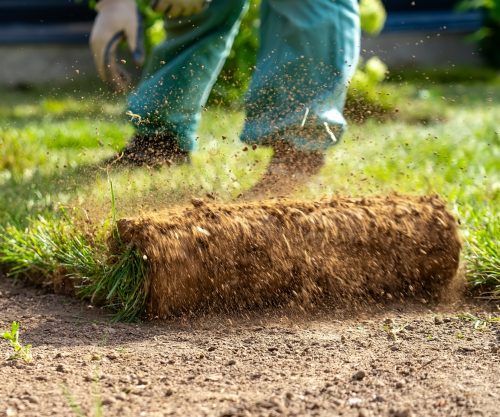- Lawn Turf
- Artificial
- Soil
- Timber
- Composite Decking
- Paving & Stone
Get In Touch With Our Experts Today!
Give us a Call! - Seed & Fertiliser
- Dressing
- Bark

June 07, 2024
lTurf laying involves proper preparation and installation to ensure the turf establishes well, resulting in a lush, healthy, and resilient lawn.
A lush, well-maintained lawn can significantly enhance any garden, providing the perfect spot to unwind and soak up the sun when summer comes around. Attaining a pristine lawn throughout the year is straightforward with some practical tips.
With the right preparation and techniques, you can create a flawless lawn that adds both aesthetic and functional value to your garden. From soil preparation and measuring the area to choosing the best quality turf and mastering the laying process, we cover everything you need to know to transform your outdoor space.
You want to loosen the soil (about 150mm deep) to give your new turf roots a chance to successfully embed. Use a rotavator or garden fork to turn over the area. The soil should also be free of stones larger than 10mm. Rake the area flat and if you need to increase the height of your new lawn, add a layer of topsoil. Again, rake it flat and gently compact down by using a compaction plate or doing the “Gardeners’ Walk”, where you shuffle your feet along the surface – get the whole family involved with this!
Top turf tip – Avoid using weed fabric or membrane under your lawn. This is a suggested solution to stop weeds. However, it stops the new turf from putting its roots down into the soil.
Before you place an order for garden turf, it’s essential to measure the area accurately to determine how much turf you’ll need. Use a tape measure to get the dimensions of your space and calculate the total square meters required. For assistance in figuring out the precise amount of turf needed, you can use our handy Turf Calculator. If you have any questions or need further help with your measurements, don’t hesitate to contact us. We’re here to ensure you get exactly what you need for a beautiful, lush lawn.
Turf laying involves starting how you would with a puzzle, starting with the edges of your lawn to form a border. This will help stop the size of your lawn from shrinking and moving over time as these tend to be whole pieces of turf.
Next, pick the centre focal point of the lawn from its main viewpoint (i.e., patio doors or steps), and lay a line of turf away from this centre point. Once you reach the other edge, turn around and lay the next row as “return”, in the opposite direction. Aim to stagger the pieces, like a brick wall, to avoid any gaps. Repeat until the area is full to achieve the perfect striped lawn.
Top turf tips:
Make sure you lay at least a quarter of a turf roll. If a piece is going to be smaller, cut it into two so each piece is larger than a quarter. This will help prevent shrinkage.
Place laying boards on the row of turf you’ve just laid; they’ll protect it from leaving footprints or creating hollows. It also helps to gently press the rolls of turf down into the soil.
Proper preparation and lawn turf installation ensure the turf establishes well, resulting in a lush, healthy, and resilient lawn. Here are some of the best tips for laying turf:
Once your turf rolls have been laid and established. Regular mowing, watering, and fertilisation will help maintain a healthy and vibrant lawn.
Proper soil preparation, careful installation, and consistent maintenance contribute to your turf’s long-term health, appearance, and resilience. By following these tips, you can increase the likelihood of successful turf establishment and enjoy a vibrant lawn all year round.
George Davies wanted to give you a thorough but easy to follow, step-by-step guide. This guide shows you how to get that professional finish to your project.
He breaks each step down, giving you an idea of what you need to start making your dream garden. There are top tips on how to achieve the very best look for your new lawn.
He talks about instant stripes, watering. As well how to measure odd shaped areas because let’s face it, no one has a perfectly uniform square garden!
So, check out the video below on how to lay turf rolls!
CALL US NOW ON 01234 818 253